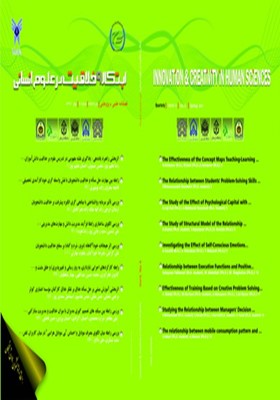-
-
List of Articles
-
Open Access Article
1 - Effectiveness of the teaching-learning strategy concept mapping in science teaching on the students' creativity Sixth grade elementary
Reza Azimpoor Mphsen Eisavi ehsan azimpoor -
Open Access Article
2 - The relationship between students' problem-solving skills and creativity mediated By self-efficacy: Modelling structural equations
Fatemeh Mahzoonzadeh Bushehri -
Open Access Article
3 - The effect of psychological capita Mediation by motivation on Students' Creativity
Arsalan Irajirad Elahe Malekzadeh -
Open Access Article
4 - A Study of Structural Model of The Relationship between Knowledge Management Process and Managerial Skills with Mediatory Role of Creative Thinking among Isfahan High School managers and teachers
Ali Shamsi Saeid Rajaii por Reza Hoveida -
Open Access Article
5 - Investigating the Effect of Self-Conscious Emotions (Pride, Shame and Guilt) on the Creativity of University Students
Ali Grayely Alireza Khorakian Yaghob Maharati -
Open Access Article
6 - Relationship between executive functions and positive and negative mood and creativity of students.
Katayon Fakhr avari Mohammad Hosein Abdalahi Mahnaz Shahgholian -
Open Access Article
7 - Effectiveness of training based on creative problem solving (CPS) on creative thinking among the Employees of Kosar Credit Institute
Morteza Shaebani Hasan Maleki Abas Abas por Esmaeil Saedi por -
Open Access Article
8 - Studying the Relationship between Managers' Decision Making Styles with the Level of Creativity and Participative Management in Guidance Schools
Leili Mazaher Sharareh Mohammadi ehsan Ekradi Ehsan Parvin Hasan Fazeli -
Open Access Article
9 - the relationship between mobile consumption pattern and "No Mobile Phobia" among mobile users in Tehran
Saeid Askari Ali Delavar Ali Akbar Farhangi
-
The rights to this website are owned by the Raimag Press Management System.
Copyright © 2021-2025







